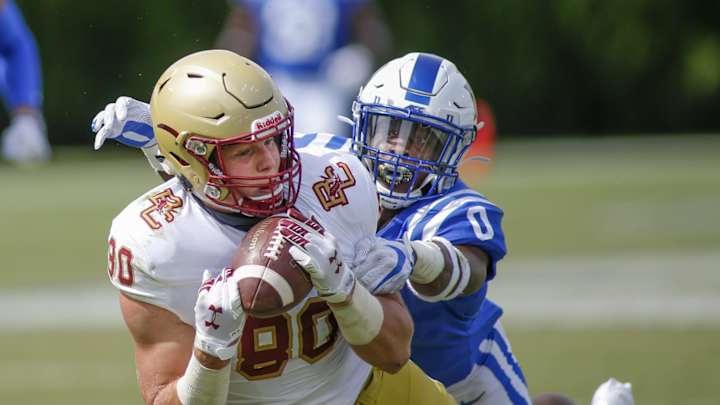Titans Draft Board: Tight Ends

In preparation for the 2021 NFL Draft, All Titans will take a position-by-position look at prospects who could be of interest to the Tennessee Titans (and available at pick No. 22 or later) and why.
Today: Tight ends
Overview: Tennessee used four tight ends regularly in 2020. All four – Jonnu Smith, Anthony Firkser, MyCole Pruitt and Geoff Swaim – had a different set of skills, and all four had contracts that expired at the end of the season. Firkser and Swaim have since re-signed, but Smith – the most dynamic and well-rounded of the bunch – is now in New England. As a result, the Titans currently have two situation-specific players at that position but not an every-down guy who can create headaches for opposing defenses.
Degree of need: Fairly High
RELATED CONTENT
- Titans Draft Board: Cornerbacks
- Titans Draft Board: Wide receivers
- Titans Draft Board: Tackles
- Titans Draft Board: Safeties
DAY ONE OPTIONS
None. The only tight end who looks worthy of a first-round pick is Florida’s Kyle Pitts, and it is highly unlikely that he will make it out of the top 10. In fact, many draft analysts believe Pitts will be the first pick for former Titans offensive coordinator Arthur Smith as head coach of the Atlanta Falcons (fourth overall).
DAY TWO OPTIONS
Hunter Long, Boston College (6-5, 254): This is a player coach Mike Vrabel no doubt knows well because he was a college teammate of Vrabel’s son, Tyler, starting right tackle. Long led all FBS tight ends in targets (89) and receptions (57) last season. He also is an effective and willing blocker who was a starter for two years in college. This definitely is a guy to watch when it comes to the Titans, who currently have one second and two third-round picks.
Pat Freiermuth, Penn State (6-5, 250): At this time last year, there was talk that Freiermuth was a likely first-round pick and possibly would be the first tight end off the board in 2021. A shoulder injury ended his 2020 season after four games and required surgery to correct. Before he was hurt, he caught 23 passes for 310 yards and a touchdown. For his career, he averaged 12.9 yards per reception and scored on touchdown on every 5.75 receptions. He will make his reputation as a receiver, but he has the size and the athleticism to become a capable blocker as well.
Brevin Jordan, Miami (6-3, 245): A well-rounded player who lined up at multiple positions, including in the backfield, last season. In three seasons, his receptions numbers were consistent – 32, 35 and 38, respectively, -- but his yards per reception increased each year. He also scored seven of his 13 career touchdowns last season. He is particularly dangerous running after the catch and is a competitive blocker who likely can add bulk as a professional. For a team that makes good use of its tight ends, such as Tennessee, he is an appealing prospect who compares favorably to Smith, a third-round pick by the Titans in 2016.
DAY THREE OPTIONS
Noah Gray Duke (6-3, 240): The fact that he was a high school quarterback speaks to his athleticism. As a tight end, those physical gifts are apparent in his precise route running and the ease with which he catches with his hands. Duke used him primarily as a receiver but lined him up at multiple spots in the offense, which will attract the attention of imaginative offensive staffs. He will have to prove he can be a proficient blocker in the NFL or simply settle into a role as a receiving specialist.
Kenny Yeboah, Ole Miss (6-4, 247): He spent four years at Temple before he finished his college career at Ole Miss. Against SEC competition, he set career-highs with 27 receptions, 524 yards and six touchdowns in 2020 – all in just seven games. He lined up most often in the traditional tight end spot, alongside a tackle, and did most of his work as a receiver in the middle of the field. Scouting reports suggest he can be much more versatile in the NFL. As a blocker, he won’t dominate but can execute certain blocks well enough to be effective.
John Bates, Boise State (6-5, 250): His size and an athletic background (he was a high school state champion in hurdles and javelin) that NFL teams will like. His production in college – 47 catches in 46 games – leaves a little something to be desired. It is likely that he will be best in the NFL as a quarterback’s safety net, running short to intermediate routes. He also likely won’t be NFL-ready as a blocker but has the attributes to develop in that area.
